Section 1 Introduction
This Statement of Community Involvement (SCI) has been prepared by Calderdale and Huddersfield NHS Foundation Trust (“CHFT” “the Trust”) and outlines the programme of engagement the Trust has undertaken for its proposals to build a new Learning and Development Centre (LDC) on Dryclough Close, next to Calderdale Royal Hospital (CRH)
The engagement exercise has been undertaken in advance of the submission of a planning application to Calderdale Council for consideration and determination for a new LDC.
This SCI includes the planning application and responds to feedback received during the engagement for the new LDC.
This SCI identifies the comments made in relation to the proposal and how these comments have been considered by the Trust in advance of the submission of the planning application.
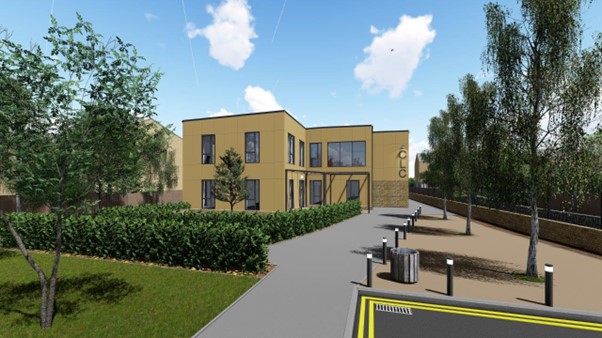
Background
CHFT has been awarded funding to invest in local health services and parking and travel arrangements at Huddersfield Royal Infirmary (HRI) and Calderdale Royal Hospital (CRH). The proposals include the construction of new healthcare buildings and car parking at CRH. Following receipt of outline planning permission, and subject to final confirmation of Treasury approval, construction is due to start in 2023.
In preparation for the construction of the new healthcare buildings and the expansion of A&E some essential pre-work is needed on the CRH site. This includes the relocation of the Rainbow Child Development Centre and the Learning and Development Centre (LDC) which are both located by the Godfrey Road entrance to the CRH site.
The Trust plans to close the existing LDC and create a new LDC facility on Dryclough Close, located next to the hospital on land where there is currently former NHS housing, which is no longer fit for purpose, is unused and in need of demolition. Planning permission to demolish these buildings has previously been approved.
Scope of Engagement
A programme of stakeholder engagement with key politicians and council officers has taken place to inform them about the project. CHFT colleagues, many of whom live local to the hospital sites, have also been engaged throughout this process. This work will continue throughout the project.
The relaxation of COVID-19 restrictions has enabled printed information to be hand delivered to local residents and businesses who are local to the planned building. This information encouraged feedback from the local community in a variety of ways; via phone call, email, online survey and written responses. This has allowed us to reach beyond the traditional contributors to pre-application surveys.
Structure
This Statement is structured as follows:
- Section 2 - a summary of the national and local planning policy guidance followed by CHFT.
- Section 3 - the proposals for the new LDC.
- Section 4 - the scope and methods of engagement with the community undertaken during the pre-application stage.
- Section 5 - the main comments received during the engagement.
- Section 6 - summarises the key themes and topics identified through the consultation and the Trust’s response.
- Section 7 - concludes the report to summarise the outcome of the engagement process.
Section 2 - National Planning Policy and Guidance
This section outlines the planning policy context relating to consultation at both a national and local level which CHFT has fully considered and complied with in guiding its engagement strategy programme.
Consideration of National Policy and Guidance is set out below along with identifying the advice in Calderdale Councils Statement of Community Involvement Guidance.
National Planning Policy and Guidance
The National Planning Policy Framework (NPPF) (February 2019) acknowledges that early engagement has significant potential to improve the planning application system for all parties involved, in terms of both efficiency and effectiveness.
The NPPF recognises that this approach can result in improved outcomes for the community (paragraph 39).
The Government makes clear that Local Planning Authorities (LPAs) have a key role to play in encouraging other parties to take advantage of the pre-application stage. Where they think it would be beneficial, applicants should be encouraged to engage with the local community before submitting their applications (paragraph 40).
Furthermore, statutory consultees are also encouraged to engage in early pre-application discussions by adopting a proactive approach and providing advice in a timely manner. In doing so, this will help the developer to avoid unnecessary delays and costs (paragraph 41).
Planning Practice Guidance (PPG) provides further information on the process and expectations on the consultation of planning applications. The Consultation and pre-decision matters guidance of the PPG focuses on the requirements and good practice of the Local Planning Authority rather than that of the applicant.
However, the PPG notes that the pre-application process is collaborative and involves the prospective applicant and other parties. This may include the LPA, statutory and non-statutory consultees, elected members and local people .
Paragraph ref. 010 Reference ID: 20-010-20150326 of PPG states that although pre-application engagement with the community is not mandatory, it is encouraged where it will add value to the process and outcome.
The Applicant has considered this guidance when structuring its engagement strategy, specifically by:
- Informing the community of its emerging proposals;
- Enabling the community to put forward ideas and discuss opinions; and
- Ensuring engagement took place prior to the submission of the Planning Application.
The Localism Act
The aim of the Act is to increase public participation in the decision-making process and has emphasis on the planning process. The Act under Chapter 4 61W states:
The person must publicise the proposed application in such manner as the person reasonably considers is likely to bring the proposed application to the attention of a majority of the persons who live at, or otherwise occupy, premises in the vicinity of the land.
It goes on to indicate in 61X (Duty to take account of responses to consultation) that the applicant must take in to consideration responses made during the community consultation process:
The person must, when deciding whether the application that the person is to make should be in the same terms as the proposed application, have regard to any responses to the consultation that the person has received.
Calderdale Council’s Statement of Community Involvement
This document outlines how stakeholders and the local community should be involved in the pre-application process. Section 8.12 ‘Consultations before planning applications’ mentions that ‘…applicants will be encouraged to undertake pre-application public consultation that is tailored to reflect the nature and scale of the proposed development’. It goes on to say ‘…failure by the applicant to consult could lead to objections being made which could affect and delay the processing of the application’.
As outlined in Table 3.2 on page 14 of the Council’s SCI, all major planning applications (defined as: sites providing 10 or more dwellings or residential applications over 0.5 ha; other development where floorspace is over 1000 sq.m. or where the site is over 1 ha; All mineral working or waste development applications) are statutorily required to undertake the following consultation methods:
- Local newspaper advertisement
- Site notices to be displayed in at least one place on or near the application site for not less than 21 days; or
- Neighbour notification letters.
Section 3 - The Development Proposal
The new facility will be located on Dryclough Close, currently the site of former NHS housing.
The LDC is a vital asset for all our NHS staff working at both hospital sites and in our community settings to learn new skills and maintain high standards of clinical ability to ensure they are at the forefront of all healthcare innovation and best practice.
The new LDC will have a clinical simulation suite where healthcare professionals can be trained and practise realistic scenarios with state-of-the-art mannequins.
There will be a library with all the latest healthcare journals and publications along with education and teaching spaces for both team and individual learning.
Outside there will be landscaped gardens planted to encourage insects, butterflies, and birds to support biodiversity in the area.
There will be a solar power system to enhance the electricity source as part of our aim to deliver an energy efficient building which will be built to complement the surrounding buildings.
In addition, we will be using new construction methods (Modern Methods of Construction) to reduce waste and CO2 emissions on the site by more than half.
The actual building installation mechanism is a modular system where the main structure will be made off site then lowered into position. This will mean less disturbance to neighbours due to a much-reduced period of work on site and fewer contactors’ vehicles involved.
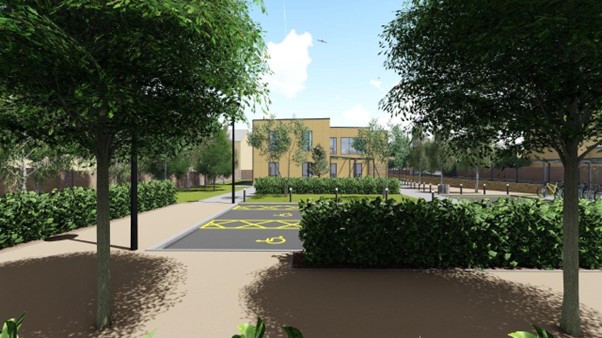

Section 4 – Engagement Activity
A localised programme of community engagement has been undertaken to suit the scale of the development in accordance with local and national planning guidance.
Briefings have been held with local ward councillors, the local MP for Calderdale and Calderdale planning officers.
Residents and businesses in the area of the proposed new facility have received letters and leaflets inviting them to “Have Their Say” and learn more about the proposals for the new LDC. These were delivered over the weekend of October 14 to 17 2022. The survey was open until midnight on 30 October 2022.
Residents were also invited to leave messages on a telephone hotline and send queries to a designated email address to offer as many different opportunities as possible to share their views.
The Trust offers all the promotional material in other languages upon request.
Local press activity
The survey has also been promoted by the Halifax Courier, on their website.
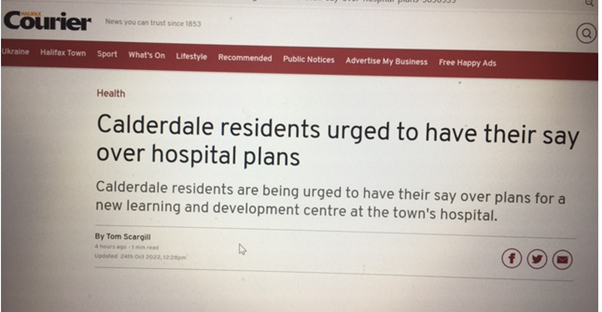
Website portal
A website was used to promote the engagement of the new LDC which can be found at Home - CHFT Future (cht.nhs.uk)
It is easily accessible via the Trust’s website and via searches using common search engines e.g. Google. This site presents all the latest news and updates about the project.
It is also the location for all feedback from our local communities, both specific surveys and ongoing comments.
Community Engagement
In line with good practice, community engagement on the planning intention was undertaken.
Letters were delivered by hand to immediate neighbours to the proposed site of the new facility on Oakleigh Avenue and St Albans Road. A copy of the letter can be seen at Appendix 1.
Leaflets (shown in the image below) were delivered to homes and businesses in close proximity to the proposed site. This included residents of Dryclough Lane; Stafford Parade; Rhodes Avenue; the Bowling Club; Belvoir Gardens; Haddon Avenue; Bayswater Terrace; St Albans Avenue and Skircoat Green Road (all the properties on the side of the road nearest the hospital).
Briefings have also taken place with Skircoat Ward Councillors and Halifax and Calderdale MPs.


Stakeholder Engagement
There are ongoing sessions in place to keep stakeholders up to date with progress across the reconfiguration programme. The development of a new LDC was confirmed across these regular meetings. These included:
- Ward Councillors for Skircoat Ward
- Members of Parliament (Holly Lynch, Craig Whittaker)
- Meeting of Transformation Programme Board (CHFT)
- Calderdale Council Planning Leads
- Partner organisation briefings
Key discussion points included:
- Advice on public involvement – keen to ensure that local residents are able to contribute.
- The design and appearance of the development.
Engagement with CHFT staff
CHFT employ in the region of 6,000 staff, many who use the LDC facilities and many of whom are also local residents. They were also asked for their feedback.
As shown below, the Have Your Say feedback was promoted in the CHFT News (Monday) CHFT Live (Wednesday) and the CEO’s Friday Briefing. (Appendix 2)
It was also promoted on screensavers throughout the go-live period up to October 30, 2022 and via the Electronic Staff Record (ESR).
The leaflet used was also distributed across meeting areas within the Trust and in the existing LDC.
Routine colleague briefings included the development plans for the LDC along with the details to provide feedback. These included:
- Matron and Nurse Forum
- Leadership Briefing
- Learning and Development Centre team
- Divisional Senior Management Teams
- CHFT Network Group - Pride Network
- CHFT Network Group - Colleague Disability Group
- CHFT Network Group - Women’s Voices Network
- CHFT Network Group - Racial Equality Network
CHFT News
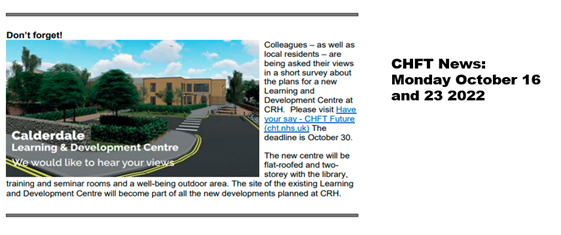
CHFT Screensaver

ESR Banner
The banner below was added to the Electronic Staff Record (ESR) from the 19 October to 30 October 2022. (The Electronic Staff Record (ESR) is the national workforce solution for the NHS. ESR Employee Self-Services offers access to payslips, total reward statements and e-learning.)
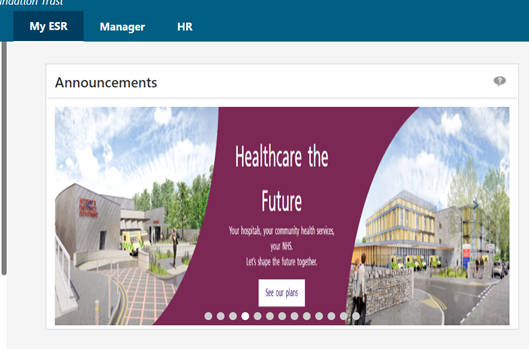
Engagement with Colleagues from The Dales
As an immediate neighbour to the LDC site, a separate engagement plan was developed to engage with the team from The Dales Unit. The South West Yorkshire Partnership Foundation Trust (SWYPFT) run this facility, providing inpatient and outpatient mental health services at the unit.
This took the format of monthly meetings from July 2022. A site visit was included with Infection Prevention and Control (IPC) in August to review the potential impact of demolition and construction, followed by a Design focussed site walk around in September with colleagues from The Dales, CHFT and the design team.
In response to this engagement the following IPC actions were agreed:
- Tall hoarding would be provided around the site during the demolition and construction phases of work
- Ventilation filter changes would be carried out within The Dales
The engagement led to the following changes in design:
- Window treatment options have now been included in the design to provide obscure glass or pictorial film on windows facing The Dales as required
- Additional planting will be provided on the boundary between the sites
- The use of anti-climb pipes on the exterior of the building have been included in the design
- The use of narrow window ledges, rebated or flush door handles and external lighting are being explored as far as possible
Regular contact will continue with representatives from colleagues from SWYPFT who are delivering services in The Dales through the monthly meetings as work progresses.
Section 5 - Survey Responses
Members of the public had access to the website at Home - CHFT Future (cht.nhs.uk) which included a dedicated project page for the LDC development. This provided additional information about the proposed development and a link to the survey. A phone number was also available for local residents to ring and provide feedback verbally.
The survey was split into three sections, the first allowing us to understand the contributor’s relationship to the site for development of the LDC. The second invites specific feedback about priorities for the site and what they want to see delivered. The third section was equality monitoring.
Feedback from the survey questions
117 surveys were completed during the engagement period, and as shown below in the summary of survey responses, the survey was developed to provide an opportunity to select more than one response to the questions raised.
| Option | Nos | % |
|---|---|---|
| Provision of cycling and walking facilities | 40 | 11% |
| Pedestrian access routes are pleasant, obvious and suitable for all | 75 | 20% |
| Entrance is obviously and logically positioned | 70 | 19% |
| Outdoor spaces are provided with appropriate safe lighting | 60 | 16% |
| The landscaping contributes positively to the locality | 60 | 16% |
| The building has high quality durable finish | 44 | 12% |
| Other | 22 | 6% |
| Option | Nos | % |
|---|---|---|
| I work in the hospital/for the Trust | 77 | 56% |
| I am a patient | 9 | 6% |
| I live near the hospital | 17 | 12% |
| I am a resident in the local area | 25 | 18% |
| I am a parent/carer /family of someone who uses the hospital services | 7 | 5% |
| Other | 4 | 3% |
| Option | Nos | % |
|---|---|---|
| The height, volume and skyline of the building relate well to the surrounding environment | 58 | 17% |
| The building contributes positively to its locality | 64 | 19% |
| The landscaping contributes positively to the locality | 59 | 18% |
| The building is sensitive to its neighbours and passers-by | 70 | 22% |
| High levels of environmental / sustainable performance | 64 | 19% |
| Other | 17 | 5% |
| Option | Nos | % |
|---|---|---|
| I have never used the learning and development centre | 26 | 8% |
| The building allows for appropriate levels of privacy | 49 | 14% |
| There are high levels of environmental comfort and control of comfort | 57 | 17% |
| The building is clearly understandable and easy to navigate | 66 | 20% |
| The interior of the building is attractive in appearance | 39 | 12% |
| There are good facilities for the users e.g. toilets, vending, Wi-Fi access | 82 | 24% |
| Other | 19 | 5% |
Who responded to the survey?
56% of responses were submitted by CHFT staff, a proportion who were also local residents or people who live near to the site.
18% identified specifically as residents in the immediate local area, with 12% as living near the hospital and 6% a patient. 5% were parent/carer/family of someone who uses hospital services and 3% none of the above.
Equality Monitoring
- CHFT included equality monitoring questions within the website survey. This allows us to understand more about the backgrounds of those responding, make efforts during the involvement to target feedback from underrepresented groups and gain data which can help inform future work.
- 66% of respondents work for CHFT, as well as being local residents, patients and carers. We have cross-referenced the feedback with CHFT data to understand if our response data reflects the workforce, and cross referenced with available ward data for Skircoat published by Calderdale Council to understand if our response data reflects the local area.
- Whilst there are limitations in analysing a small data set alongside the data for the entire workforce, we have drawn out some key findings:
- Gender representation is broadly reflective of the gender split in the workforce with 71% of survey responses from women compared to 81% of women in the CHFT workforce. This is significantly higher than the 51% of women in the local population and from the area perspective, men were under represented in the survey.
- There is a wide age range of respondents ranging from age 5 to age 70, and whilst there are no children working in CHFT, the average age of respondents at 41, is almost identical to the average age of CHFT which is currently 42. This also reflects the average age of the local population which is also 41.
- In terms of racial background, white contributors were slightly over represented at 81% compared to 75% of the CHFT workforce; however this is more reflective of the local population where 86.9% of the wider ward population identify themselves as white. Black and Asian contributors represented 5% of respondents; an under representation compared to both the workforce at 22% and 11% of the ward population.
- 5% responding to the survey identified as disabled, which mirrors the CHFT workforce.
6. Response to Comments
The project team has closely reviewed all feedback received during the engagement.
Each of the principal themes raised by responders to the engagement questions for the LDC and associated response is set out below.
| Number | Topic raised | Applicant’s response |
|---|---|---|
| 1 | Adequate parking and accessible parking for bulky equipment and people with reduced mobility | A small amount of accessible parking is provided on site with general parking available through the future provision of a large multistorey car park on the Hospital site. This also aims to avoid an increase of private car usage and avoid additional vehicle journeys. Collapsible bollards will be provided to allow access for a fire appliance / other emergency vehicles. This may also be used for the drop off heavy equipment for training etc if required by the end user. |
| 2 | Effective internal space | The general arrangements of the proposed building have been developed through design workshop sessions with users to create rooms to allow for flexible use, and to suit a variety of uses, with the use of floor mounted folding partitions key to aiding flexible use. The proposed building provides a number of clinical teaching rooms spread across both floors, sanitary facilities, breakout spaces and kitchenette facilities. The breakout spaces offer space for private study or a place to hold meetings. The different sized rooms provide a variety of areas to support group and individual learning, designed to be flexible and cater for varying numbers of people, with folding partitions included to further increase the flexibility of the spaces. Following user engagement workshops the main training facilities were located on the ground floor, to minimise manual handling of equipment to reduce risk to end users. |
| 3 | Sustainable /Environmentally Friendly | Solar panels will be included to drive renewable energy generation in line with sustainability targets. Occupancy lighting switches and heating will be included, so energy isn’t wasted. Lighting in offices and seminar spaces are to incorporate absence detection, and daylight dimming is to be provided to fittings adjacent to windows. In toilets and communal areas, presence detection will be utilised. External lighting is to be provided, on a timeclock and presence control, to avoid unnecessary light pollution, whilst providing safe and well-lit access. Outdoor amenity spaces will be provided with appropriate seating etc, and these will be designed in conjunction with a landscape designer and ecologist to ensure these will contribute to the biodiversity using local species. The landscaping will contribute positively to the locality. The proposed building block will be constructed using offsite modular construction techniques. The environmental benefits of an offsite factory produced building offer up to 90% less waste on site, up to 50% reduction in carbon emissions and 65% recycling of waste generated in the construction. |
| 4 | Accessible from CRH | Pedestrian access routes will be supplemented with the use of territoriality to guide building users to the main entrance and clearly demark the space. Pedestrian access routes will be pleasant, obvious and suitable for all. Provision of outdoor spaces with appropriate safe lighting. |
7. Conclusion
CHFT have carried out engagement work with local residents and stakeholders in line with the scale of the LDC development.
The engagement feedback has helped inform the development of the planning application. Feedback indicated that accessibility and parking is of major importance for people who provide training. The proposed building must be easily navigated, well laid out and with high quality facilities.
The engagement meets and exceeds the requirements laid out as part of the NPPF, the Localism Act and Calderdale Council’s Statement of Community Involvement. CHFT has also engaged during the pre-application process with planning officers at the Council to ensure a robust planning application is submitted.
The digital platform for the engagement was well publicised, with letters and leaflets distributed to local households and businesses, as well as coverage in relevant local media outlets.
Meetings with local political and community stakeholders took place, providing an opportunity for members of the project team to introduce relevant stakeholders to the proposals and receive feedback. These meetings will continue to take place throughout the project.
A particular emphasis has been placed on engaging with seldom heard groups and those who are digitally excluded. We have made materials available in other languages, sent leaflets or letters to the nearest households, offered the opportunity to discuss the plans on the telephone and via email and promoted the engagement at both hospital sites.
It is clear from the feedback forms completed that the community is broadly supportive of the proposals.
Further details of the scheme and the benefits are set out in the Design and Access Statement submitted, and other supporting material submitted for the planning application.
In summary, it has been demonstrated that an appropriate public involvement and stakeholder engagement programme has been undertaken by the Trust in advance of the submission of the planning application. The Trust will continue to involve local people and stakeholders regarding these developments.
8. Appendices
Appendix 1 – Letter to local residents


Good morning, Colleagues
Change is afoot with the end of British Summer Time this weekend, which means the clocks go back. As ever, a huge amount of planning has taken place to make sure the impacts in EPR are minimal, so if you’ve missed the detail you can see it here.
Also, this coming Sunday our quick survey on the new Learning and Development Centre at CRH closes. We’re seeking views from local residents and colleagues about the building, which forms part of our exciting future development plans. You can take part here.
So that’s October. We’ve seen a great run of Black History Month heroes, especially this week which featured former CHFT midwife Amy Bell. If you’ve not read it – it really is inspirational. So much so that Outpatients Staff Nurse, Louise Macaskill even gave her daughter Amy as a middle name because of her.
Brendan

